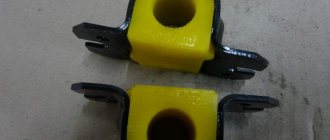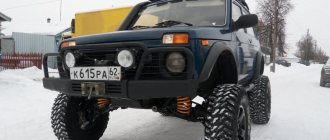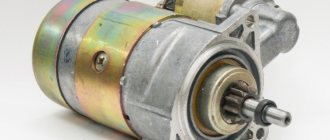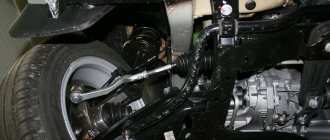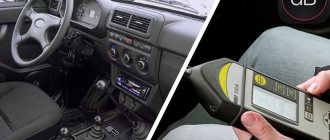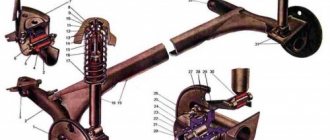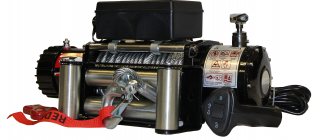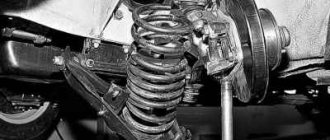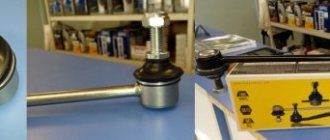Lift options
How and where you will make a lift for your crossover, decide for yourself. I will try to tell you about all the nuances of this procedure so that you understand what to expect and what to prepare for.
Let's start with the existing elevator options. Suspension modification professionals distinguish two types of such procedures:
I will say right away that a body lift lifts the entire body by using stands, modifying the hose and other parts. In theory, such tuning is very simple, but in the case of the Niva it is not used. And why all? Yes, because the Niva 2121 and other representatives of the series do not have a frame. If there was a frame, then there would be no questions.
From this we conclude that for our Niva the optimal solution would be suspension lifting. It provides the following benefits:
- increases crossover cross-country ability;
- lifts the entire machine;
- allows you to install larger wheels without having to trim the arches;
- provides the car with a more attractive appearance;
- makes the Niva an ideal car for fishing, hunting and driving on the most difficult sections of roads and off-roads.
If you raise the car by about 45 mm, achieve a lift of 50 mm, or even take the height to a bold 60 mm, you can easily insert wheels with a diameter of up to 29 inches into the factory arches. Do not forget that installing large wheels affects fuel consumption.
Many people mistakenly believe that it is easier to cut out the arches, insert 33-inch tires there and thereby raise the car. In practice, with such solutions the machine rises slightly. Most importantly, this does not greatly affect the geometric cross-country ability. I would recommend installing 31-inch wheels and lifting at the same time. This combination will provide the best result. Just choose your car wheels wisely and don’t forget about the seasonal rules for storing tires.
I'll make one remark. When lifting the car, the service life of the internal CV joint and the factory boot is reduced. To fix the problem, try replacing the internal boots on the CV joint with external ones, and also lower the FRM (front axle gearbox) by 10 mm. This way it will be possible to reduce the angle of operation of the CV joint.
Materials and tools
I don’t argue that in Samara, Nizhny Novgorod, Moscow or cities like Yekaterinburg and St. Petersburg there are many companies ready to do any amount of work on your car and suspension in particular for your money.
If you decide to do everything yourself, I have nothing against it. I only advise you to use only factory-made, high-quality kits for the Niva elevator.
Kits from Izh Techno have earned good reviews; you can also find excellent options in the store on Sedova Street in St. Petersburg. This store is called Niva 4x4. The T 34 lift kit also showed excellent performance. Each of them is excellent for the Niva, which is why it is widely used by car owners when modifying the front and rear suspension.
There is an option to assemble the kit yourself. But this will require accurate drawings and even more time and effort. I don’t see the point in this, since it is better to take a ready-made set after looking at a review of different sets.
To work you will need to take:
- front and always rear new springs;
- spacers made of rubber for springs with a metal cup;
- spacers for the Nivov ball joint (upper);
- shock absorbers;
- brackets for rear shock absorber springs;
- cup washers;
- set of tools;
- jack;
- durable boards;
- ties for working with springs.
What to pay attention to when lifting
We install a 30 mm spacer; if we do not install the spacers under the cup that come with the lift kit, you can install a longer spring or a polyurethane buffer. Then a problem appears: the spring is crooked, it can touch the body of the bump stop, constant grinding, knocking, squeaking. The Niva elevator kit is best suited. We don’t need to change the spring, we don’t change the shock absorber and the suspension works softly and at the same time the car rises by 50 mm.
Why don't we change the shock absorber? Spacers are installed under the spring cup. which maintain the same height position of the cup as on the drain. The shock absorber remains standard. If we install a long shock absorber, the upper shock absorber house will begin to break out. It sometimes cracks. Or the ears will fold on the cup.
We also need to modify the cup for the steering rod.
When turning the wheel, if the cup had not been modified, the rod would have stuck. And there was a restriction on turning, and there would be knocking when the suspension moved.
Elevator assembly
The installation procedure is divided into installing a front and, accordingly, rear car suspension lift.
There is nothing particularly complicated here. Especially for those who have already had to work with the suspension, change something, repair and dismantle it.
Let's look at the processes separately.
Front suspension
Let's start with the front of the Niva. Then I’ll tell you separately how work is done on the rear suspension of the crossover.
- It all starts with removing the wheels and releasing the silent blocks. The activities are elementary, so we won’t pay much attention to them;
- Securely secure your Niva. To do this, place a jack under the ball joint. The machine rises until the spring is fully compressed;
- Next, the ties are installed on the fastenings and the fastening elements that you will see on the Niva’s shock absorbers are dismantled;
That's it, the work is completed.
Rear suspension
Here you will have to buy yourself or borrow a welding machine from a friend, because you can’t do without welding. Get a semi-automatic one.
The procedure for lifting the rear suspension of a Niva will look something like this:
- The cups are carefully placed under the Nivov springs so as not to be damaged;
- The rear shock absorbers included in the kit are installed on the car. Additionally, I advise you to secure the bracket by welding;
- When you install the element, your rear axle will move forward slightly. To avoid such a change, all rods must be lengthened;
- The lower cup is cut off and shifted by about 20-30 mm. When moving, pay attention to the crosspieces, which are easily damaged;
- The cups are welded firmly into new places using a welding machine;
- The rocker arm of your brake system is extended. As a result, the extension should add 30 mm;
- Pins are welded under the shock absorbers using semi-automatic welding. Just not yours, but car ones.
Be sure to visit the service station after this. Not to show off the work, but to perform a wheel alignment.
Remember that lifting will require further installation of main pairs with a different gear ratio. And forget about alloy wheel sets. Now only stamped discs will be your property.
If you really want to perfect the car, then spend a little more money on a new limited-slip differential.
All responsibility for lifting lies entirely with you, even if you ordered the service from a car service center. Remember that the consequences may be very unpredictable. Although practice shows how satisfied car owners are with the elevator and that such reconstruction brings benefits and driving pleasure. The main thing is to do everything correctly and use only high-quality ingredients. Thank you all for your attention! Subscribe to our website, leave comments, ask questions and invite your friends to join us!
( 3 ratings, average: 5.00 out of 5)
Did you like the article?
Subscribe to updates and receive articles by email!
We guarantee: no spam, only new articles once a week!
We will tell you how to properly perform tuning modifications in this material.
Do-it-yourself elevator - drawings, diagrams, sizes, types of kits. Lifting varies in the degree of intervention in the standard structure. For some, it is enough to raise the SUV by a few centimeters, and for others by as much as 20.
Extreme tuning – maximizing cross-country ability for traveling on severe off-road conditions.
- Regular jack Hijack jack Spring puller Balloon wrench Set of socket heads with ratchet Set of open-end wrenches Pry bar Wooden block (stump)
It is advisable to perform such work with a partner. First of all, it's safer. Secondly, some lifting work is performed with four hands. Let's take the front suspension as an example.
Raise the front end. You can safely cling to the standard bumper, only the jack is installed under the pipe securing it.
By removing the wheel, we get full access to the lever and spring. The front suspension 21214 is made using a double wishbone design, which simplifies the task.
The lever travel is limited by the shock absorber. Unscrew its fastening and move it to the side.
Next you need to free the suspension from the anti-roll bar. The mounting bolts may become stuck due to corrosion, so we will use a penetrating liquid (such as WD-40). The stabilizer silent block clamp can be pryed off with a pry bar.
Then disconnect the hub from the lower arm. To do this, you need to jack up the suspension and fix the steering knuckle of the wheel. You can tie it with wire. Then unscrew the 3 mounting bolts and release the ball joint.
We fix the spring with ties and lower the jack. We remove the old elastic element. In some cases, it is enough to simply lower the lever with your foot, and the spring will come out without the use of ties.
the upper support rings
from the old springs . With their help, the elastic element is centered in the cups.
Installation of a ready-made lifting kit for Niva 21212
To understand the process, let’s look at the geometry of the suspension on NIVA SUVs (front axle). The drawings clearly demonstrate the position of the elements relative to each other. If you organize an elevator only by increasing the length of the spring, its bending radius decreases, and lateral loads appear on the mountings of the levers. To compensate for this side effect, spacers are used: under the spring cup and ball joint.
The standard version shows that the axle shaft (CV joint) is located virtually parallel to the ground. The spacer is installed between the spring and the lever. The radius of curvature of the elastic element is small, the softness of the suspension is maintained. The fastening is reliable, there is no backlash. Disadvantage - the additional element adds unsprung masses (aluminum parts can be used to reduce weight). The spacer is installed between the cup and the spring. There are no unsprung masses, the radius of curvature of the elastic element is even smaller than in the previous version. The disadvantage is that the attachment of the additional element is not so reliable.
In all cases, the elevator changes the position of the axle shaft. The load on the tripods (gimbals) increases. When lowering the suspension, the travel of the upper arm to the bump stop decreases. To restore the geometry, a spacer is installed under the upper ball joint. Factory kits are designed taking into account all the design nuances of the front axle and rear axle.
The set includes:
- Drawings for correct installation Spacers Extended shock absorbers New trailing arms for the axle Extended panhard rod New cups and springs
Replacement process: To install the lift kit, a garage with a pit and a standard set of repair tools are enough. Those who independently service LADA 21214 know what we are talking about. Preparation of the front axle is described in the Niva budget elevator section. Only when installing the kit is the steering knuckle removed completely. If you manage to fix it without removing the CV joint, good. Usually it is completely separated from the suspension.
Next, dismantle the lower spring cup and install three ring spacers under it. There are no more modifications to this lever. An enlarged support ring is installed on top of the elastic element.
To compensate for the divergence of the levers, we mount a spacer under the upper ball mount. Since all the parts are from the same set, the sizes are synchronized.
This element is the most responsible. If the geometry “floats”, the front suspension travel will be disrupted. To fine-tune the height, the monolithic upper ball spacer can be replaced with stacked washers. By selecting the quantity, you adjust the parameters of the front axle, just like on a rally car.
If the kit includes new shock absorbers, they should be installed. On standard ones, the rebound stroke may not be enough, and your 21212 will squirm on potholes. The rear axle is completely removed, especially if new support cups are welded under the springs. The eyelets for the levers remain standard, the extended parts from the kit have standard fastenings. Depending on the size of the front axle lift, you may be limited to raised cups, or add spacers for the springs. It is better to choose a customizable Panhard rod. You can adjust its length when changing the clearance height.
To understand the process in dynamics, you can watch a video of Niva’s independent elevator:
Installation of lift kit on Niva 2121
We are buying a lift kit for a Chevy Niva 4×4. It is ideal for a lift.
What is included in the elevator kit
It consists of a 60 mm spacer for Niva springs, a nylon bumper, and an adjustable bunk rod.
Also included is an extended brake force adjuster rod,
it is lengthened by welding the lengthening plate. This lift kit for Chevrolet Niva allows you to raise the car by 50 mm in ground clearance for installing large wheels. A caprolon spacer is needed so that the cooking wheel does not take over. A bracket is installed on the rear axle under the standard shock absorbers.
There is a standard mount and allows you to move the shock absorber higher to a height of about 40 mm.
Important! There is no point in extending shock absorbers on a standard suspension. it squeezes out the salenblocks and they don’t work for a long time, the shock absorbers quickly run out!
It makes sense to do this when you are going to install a lift kit on Niva 2121.
The bridge was raised and the brake hose was stretched, do not forget that the suspension also goes down.
Or we replace this hose with a longer one. Or we cut off the bracket and lengthen it by the same amount as this rod is lengthened. This lift kit includes a plate for transferring the hose, but if you untwist it you will have to pump the brakes. This time. We simply cut off the rod in place, digest it by first wrapping the joint with a rag and watering it with cold water, then paint over it. The lift kit for Niva 21214 is installed in the same order.
Front and rear suspension of the Niva 2112 lift
In the Niva lift front suspension, the kit consists of a spacer for the Niva, which is placed on the ball, the spacer is 30 mm.
You can't bet anymore. If we set more during the suspension stroke, the ball pin begins to break, resting against the body and tries to fly out of the cavity with nylon bushings where it is located. Comes with a standard shock absorber. Spacers on the field, which are placed under the spring cup, allow you to compensate for the height of the ball.
Thanks to this, the spring is not skewed; it stands just like on the standard suspension.
And the point of this lift kit is not just to clamp the suspension, but to lift it. If we hadn’t installed a ball spacer, but instead put a spacer under the cup, or put a longer spring, or a polyurethane buffer on top of the spring. We would have tightened the suspension, then the correct sales blocks would quickly die.
They are small compared to the big ones. The car would rise. But there was an additional load on the ball and on the salen blocks. Spacers for the rear springs of the Niva are also relevant for lifting. We need to preserve a certain geometry. The car rises by 50 mm and the Niva’s front suspension remains soft. Also, the upper bumper is cut off in half, or a Cheviniv one is installed, which is smaller in size.
The Niva 2121 lift for the front and rear suspension is done in the same way.

